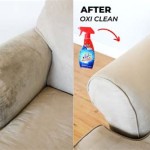Removing Dye Transfer Stains from White Leather Sofas
White leather sofas offer a sophisticated aesthetic, but they are notoriously susceptible to dye transfer. Dye transfer occurs when the pigments from dark-colored clothing, blankets, or other dyed materials bleed onto the leather surface, resulting in unsightly stains. Prompt and appropriate action is crucial to minimizing the damage and preserving the sofa's pristine appearance. This article provides a comprehensive guide to removing dye transfer stains from white leather sofas, outlining various methods and precautions to ensure effective cleaning without causing further harm.
Before attempting any cleaning method, it is essential to identify the type of leather. Most leather sofas are either protected (finished) or unprotected (aniline or nubuck). Protected leather has a surface coating that offers some resistance to stains, while unprotected leather is more porous and absorbent, making it more vulnerable to dye transfer and more challenging to clean. Identifying the leather type helps in selecting the appropriate cleaning solutions and techniques. Refer to the manufacturer's instructions or consult a professional leather cleaner if unsure about the leather type.
Furthermore, a patch test is paramount before applying any cleaning agent to the stained area. Choose an inconspicuous area of the sofa, such as the back or underneath, and apply a small amount of the cleaning solution. Observe the area for any adverse reactions, such as discoloration, damage to the finish, or changes in texture. If no negative effects are observed after 24 hours, the cleaning solution can be cautiously used on the dye transfer stain.
Initial Cleaning Steps: Gentle Surface Cleaning
The first line of defense against dye transfer stains involves gentle surface cleaning. This approach aims to remove loose dye particles and prevent the stain from setting deeper into the leather. The following steps outline the process:
1.
Dust and Vacuum:
Begin by dusting the sofa with a soft, dry cloth or microfiber duster. Follow this with vacuuming the affected area using a soft brush attachment to remove any loose dirt, debris, and dye particles. This prevents abrasive particles from further scratching the leather surface during the cleaning process.2.
Gentle Wipe with a Damp Cloth:
Prepare a clean, soft cloth and dampen it with distilled water. Wring out the cloth thoroughly to ensure it is not overly wet. Gently wipe the stained area in a circular motion, avoiding excessive pressure. Over-wetting the leather can cause water stains and potentially damage the material. Repeat this process with a clean section of the cloth until no more dye is transferred onto the cloth.3.
Mild Soap Solution (For Protected Leather):
If the stain persists after wiping with water, prepare a mild soap solution using a pH-neutral leather cleaner or a very mild dish soap diluted in distilled water. Again, dampen a clean, soft cloth with the solution and gently wipe the stained area. After cleaning with the soap solution, wipe the area with a clean, damp cloth to remove any soap residue. Thoroughly dry the area with a clean, dry cloth.These initial cleaning steps may suffice for minor dye transfer stains on protected leather. However, more stubborn stains may require more specialized cleaning methods.
Specialized Cleaning Methods: Addressing Stubborn Stains
When gentle cleaning methods fail to remove the dye transfer stain, more specialized cleaning agents and techniques may be necessary. These methods should be used with caution and always preceded by a patch test due to the potential for damaging the leather.
1.
Leather Cleaner Specifically for Dye Transfer:
Several leather cleaners are specifically formulated to remove dye transfer stains. These products often contain mild solvents or enzymes that help break down the dye molecules without damaging the leather. Follow the manufacturer's instructions carefully when using these cleaners. Apply the cleaner to a clean, soft cloth and gently blot the stain, working from the outside in. Avoid rubbing vigorously, as this can spread the stain or damage the leather. After applying the cleaner, wipe the area with a clean, damp cloth to remove any residue and dry thoroughly.2.
Rubbing Alcohol (Isopropyl Alcohol):
Isopropyl alcohol can be effective for removing some dye transfer stains, but it should be used with extreme caution, especially on unprotected leather. Dilute the rubbing alcohol with equal parts of distilled water. Apply the diluted solution to a clean, soft cloth and gently blot the stained area. Avoid rubbing vigorously, as this can remove the leather's finish. Work in small sections and frequently change to a clean section of the cloth to prevent re-depositing the dye. After applying the alcohol solution, immediately wipe the area with a clean, damp cloth to remove any residue. Follow with a leather conditioner to help restore the leather's moisture and prevent drying.3.
Melamine Sponge (Magic Eraser):
Melamine sponges, often referred to as "magic erasers," are abrasive cleaning tools that can be effective for removing some stains. However, they should be used with extreme caution on leather, as they can damage the finish and cause discoloration. Dampen the melamine sponge with water and gently rub the stained area. Use very light pressure and frequently check the progress. Avoid rubbing too hard or for too long in one spot. After using the melamine sponge, wipe the area with a clean, damp cloth to remove any residue and follow with a leather conditioner.4.
Professional Leather Cleaning:
For particularly stubborn or extensive dye transfer stains, or if unsure about attempting any of the above methods, it is best to consult a professional leather cleaning service. Professional cleaners have the expertise and specialized equipment to safely and effectively remove dye transfer stains from leather without causing further damage. They can also assess the leather type and recommend appropriate cleaning and restoration treatments.Preventative Measures: Protecting Your White Leather Sofa
Prevention is always better than cure. Implementing preventative measures can significantly reduce the likelihood of dye transfer stains occurring on a white leather sofa. These measures include:
1.
Use Leather Protectors and Conditioners:
Applying a leather protector can create a barrier between the leather and potential sources of dye transfer. Leather protectors are available in various forms, such as sprays or creams. Follow the manufacturer's instructions for application. Regular conditioning helps maintain the leather's suppleness and prevents it from drying out and becoming more susceptible to staining. Condition the leather every few months or as needed to keep it in optimal condition.2.
Avoid Dark-Colored Clothing and Materials:
Be mindful of the clothing and materials that come into contact with the sofa. Avoid sitting on the sofa wearing dark-colored or new clothing, especially denim, as these are more likely to transfer dye. Similarly, avoid placing dark-colored blankets, pillows, or other items on the sofa, as they can also transfer dye over time.3.
Regular Cleaning and Maintenance:
Regular cleaning and maintenance can help prevent dye transfer stains from becoming permanent. Dust and vacuum the sofa regularly to remove loose dirt and debris. Wipe the sofa down with a damp cloth every few weeks to remove surface dirt and prevent buildup. Promptly address any spills or stains to prevent them from setting into the leather.4.
Consider Furniture Covers:
If the sofa is frequently exposed to potential sources of dye transfer, consider using furniture covers or throws. These covers can be easily removed and washed, providing an extra layer of protection for the leather.5.
Avoid Direct Sunlight:
Prolonged exposure to direct sunlight can cause the leather to fade and become more susceptible to damage. Position the sofa away from direct sunlight or use curtains or blinds to shield it from the sun's rays.Removing dye transfer stains from white leather sofas requires patience, care, and the use of appropriate cleaning methods. By following the guidelines outlined in this article and implementing preventative measures, it is possible to maintain the pristine appearance of a white leather sofa and enjoy its beauty for years to come. Always remember to prioritize safety and test any cleaning solution on an inconspicuous area before applying it to the stained area. When in doubt, seek professional assistance to avoid causing irreversible damage to the leather.

How To Remove Dye Transfer Stains On Leather

How To Clean White Leather Furniture

How To Get Blue Dye Off Of White Leather Ehow

Restoring White Leather Sofas

Remove Blue Stains From White Leather

Dye Transfer Ruins Upholstery This Is What You Can Do Knight Doyle

How To Clean And Re A White Leather Couch Fc

How To Clean White Leather Furniture

Customer Results Restoring A White Leather Sofa Sofas Furniture Clean

How To Clean White Leather Remove Dirt Stains








